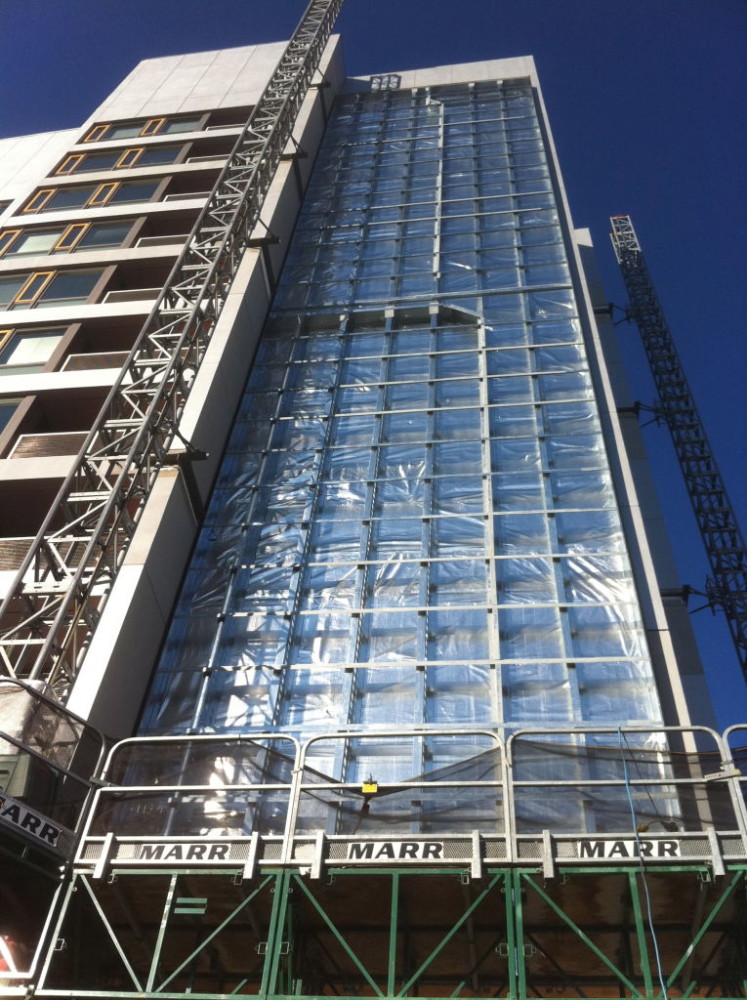
Photos courtesy Cambridge Housing Authority (CHA)
By Brian Wilkinson
A 210-m2 (2250-sf) unglazed, transpired solar air-heating collection (TSAC) system has greatly improved the energy efficiency of Cambridge, Massachusetts senior housing. The Lyndon B. Johnson (LBJ) Apartments, a 180-unit development owned by the Cambridge Housing Authority (CHA), benefited from the technology, which integrated aesthetically, seamlessly, and cost-effectively within its architecture.
These solar air-heating collectors have high operating efficiencies of 70 to 89 percent, and utilize existing building mechanical systems in high-rise applications in order to function. Such systems are designed for cold climates, demonstrating an incremental payback history of two to eight years—ideal installations are located in areas with cool weather but significant sunshine. Given the relatively quick payback, and ease of integration on new or retrofit applications, building owners planning façade renovations should evaluate whether a transpired solar air-heating system is a viable option.
At the LBJ Apartments, as in most northern latitudes, a dark, perforated, metal cladding (i.e. absorber) is installed on a south-facing wall over the building’s ventilation intake system. Both diffuse and direct solar radiation strike the absorber; as the air passes through the perforations, the sunlight is converted into heat.
Outdoor air is drawn through the perforated exterior cladding at flow rates of 7 to 12 m3/h (4 to 7 cfm/sf) of collector area and into the void cavity between the cladding and the building’s exterior structural wall. Higher air flow rates are suggested for high-rise applications to mitigate the impact of heat loss due to ambient wind on the absorber. As the air travels through the system, it is heated up to 25 C (45 F) over ambient temperatures; the warmed air is then drawn into the building as fresh ventilation air.
According to American Society of Heating, Refrigerating, and Air-conditioning Engineers (ASHRAE) 55, Thermal Environmental Conditions for Human Occupancy, the temperature of the air in a building should range from 20 to 24 C (68 to 75 F) during the winter. Transpired solar air collectors serve to pre-heat ventilation air to up to 23 C (73 F) without using other fuels, reducing energy demand.
The 209-m2 (2250-sf) black, wall-mounted transpired solar air-heating collector was raised 12 stories, covering the south-facing wall of LBJ Apartments, harnessing solar radiation to cost-effectively pre-heat 17,000 m3/h (10,000 cfm) of fresh air as it is drawn into the building’s ventilation system, providing substantial energy savings during the heating season.
“The energy retrofit at LBJ Apartments is a showcase for clean, renewable technologies,” said Greg Russ, CHA executive director. “The specified solar heating system is part of the technology package that will contribute to our effort to reduce our environmental footprint by adding renewable energy technology that pays for itself, improves the building performance, and introduces new energy conservation techniques to the region.”

The $2-million project was financed through a $10-million grant under the American Recovery and Reinvestment Act (ARRA) implemented by the U.S. Department of Housing and Urban Development (HUD), and is designed to meet the standards of HUD’s Green Communities Program for Substantial Renovations. It is one of only 36 projects in the nation funded under the grant program, requiring commitment to a “transformative change” in the approach to energy use.
The project is on track for a 50 percent reduction in energy use at the property, as well onsite renewable energy generation exceeding 10 percent of the projected post-retrofit energy needs. The solar air-heating system custom-designed for LBJ Apartments will produce approximately 300 million BTUs of solar heating during each heating season, cutting annual natural gas consumption by more than 100,000 kWh—over $5000 in savings—while providing an annual 18-tonne reduction in carbon dioxide (CO2) emissions. In addition to being maintenance-free, unglazed TSACs are recognized for their air filtration ability showing a 50 percent reduction in particulate matter entering the HVAC system resulting from the static buildup of dirt particles around the perforations that are cleaned naturally by rainfall.
Brian Wilkinson founded Matrix Energy in a Montréal, Québec-based company specializing in solar air-heating solutions in 1985. A graduate of Concordia University, he is a past-president and chair of the Canadian Solar Industries Association (CSIA) and member of Natural Resources Canada’s (NRCan’s) Solar Thermal Advisory Committee. Wilkinson can be contacted by e-mail at bwilkinson@matrixairheating.com.





Great to see this article! This technology is under-promoted in the architectural/HVAC world, and often that comes from the media just not being aware these projects are taking place. My company was engaged to engineer and install the system, and provided the photo’s from the article. If anyone would like more photo’s or information, please feel free to reach out at info@shiftnrg.com and we’re happy to provide. More case study information is also at http://www.shiftnrg.com/lbj-apartments-cambridge-ma/